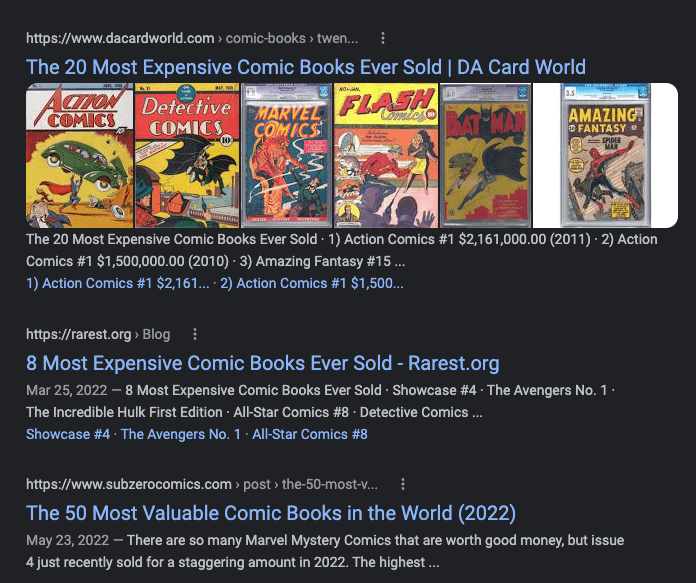- Home
- Blog
- Content Marketing
- What Is a Content Gap? (& How to Do a Content Gap Analysis in 3 Steps)
What Is a Content Gap? (& How to Do a Content Gap Analysis in 3 Steps)
-
 8 min. read
8 min. read
-
 Macy Storm
Macy Storm Content Marketing Consultant
Content Marketing Consultant
- Macy is a content marketing consultant with over five years of experience creating content for dozens of industries including home services, recreation, and education. She’s written about every marketing topic under the sun, from SEO to AI to email marketing. Her work has been featured by Search Engine Journal, HubSpot, Entrepreneur, Clutch, and more. In her free time, Macy enjoys crafting, reading comic books, and walking her dog Daisy.
Have you ever searched on Google, only to find that the results don’t quite answer your question?
If so, you’ve experienced a content gap. Numerous queries on the web result in unhelpful answers because there aren’t any answers.
So, what can your business do about it?
On this page, we’ll cover everything you need to know about content gaps, including:
- What is a content gap?
- Why do you need to find content gaps?
- How to do a content gap analysis
- Tips for filling in content gaps
Keep reading to learn more!
And if you want to get tips and tricks for creating compelling content, subscribe to our newsletter, Revenue Weekly, for the latest tips and tricks!
What is a content gap?
A content gap is a void of missing content when users search for information. These areas don’t have adequate answers to searchers’ questions, deliver outdated information, or don’t clearly present the information.
Why do you need to find content gaps?
Now that I’ve answered, “what is a content gap,” you’re probably wondering why it matters. Why do you need to know about these gaps and fill them?
Here are a few key reasons you’ll want to find content gaps:
- A content gap creates opportunity: If there are topics or keywords out there that your competition hasn’t even touched, it’s an opportunity for you to shine. You can create content on that topic before anyone else does, helping you earn valuable traffic.
- A content gap helps you build authority: If you’re the only credible source ranking in content gap areas, you set yourself up as an authority. People will trust your business and information because you’re the foremost authority on the subject.
- A content gap helps you perform better: When you’re filling content gaps, you help improve your content’s overall performance by driving more traffic and leads. It’s a great way to boost your website’s performance in search engines and improve your SEO.
By doing a content gap analysis to identify gap areas, you reap numerous benefits of creating content within those gaps.
Content gap analysis: How to find content gaps in three easy steps
Now that you know the benefit of finding content gaps, it’s time to do your content gap analysis for SEO. Here are three steps to help you identify content gaps:
1. Conduct competitor keyword research
The easiest way to identify content gaps is to conduct competitor keyword research. You can use a tool like SEMrush or Ahrefs to help you find the right content.

All you need to do is take a page from a competitor’s website and put it into the tool to see what keywords they rank for in search results. From that point, you can search those keywords on Google and see what results it generates.
If you look at the search results and don’t see many authoritative sites ranking for those key terms, you have a prime opportunity to be the one that does.
More on closing the keyword gap in the video below!
2. Look at what’s already ranking for keywords
Now, let’s say you conduct your content gap analysis and find some strong competitors ranking for the keyword. The next step is to analyze those pages that already rank for the keyword.
This step is critical because it helps you identify where gaps lie within the content that already ranks. You’ll want to look at each page and analyze the following areas:
- Thoroughness: How in-depth does the page cover the topic? If the pages graze over the subject, you have an opportunity to outperform competitors by covering the topic more in-depth.
- Focusedness: Does the content stay focused on the topic at hand? If there’s content that seems all over the place or disorganized, you have an opportunity to create better-planned content.
- Freshness: How recently was this content created? If there are pages that are three or more years old ranking in the results, you have a prime opportunity to create fresh content. You can provide updated information for searchers.
- Readability: Can you understand the content? If it’s too jargon-heavy or confusing, you have an opportunity to explain the topic clearly and concisely to searchers.
- Style: Is the content interesting and engaging? If other companies aren’t creating shareable content, you have an opportunity to create a more engaging piece that attracts leads and earns shares.
When you do a content gap analysis for SEO, you’ll want to analyze these different areas to see if the pages already ranking fit this bill. If there are one or two areas where they fall short (say readability and freshness), you can deliver better content in those areas.
3. Identify what the content misses
The last step of your content gap analysis is to identify what’s missing from the content that’s ranking. Analyzing the key areas listed above is a starting point –– you need to figure out what’s missing or not happening on the page.
Let’s say you conduct your content gap analysis and find pieces that fall short in the areas of thoroughness, readability, and style.
Looking at the thoroughness, you may find that people only provide one or two tips for the topic or don’t cover the benefits. You can make up for missing pieces by adding them to your own.
Regarding readability, you may analyze the piece and find it uses way too much jargon, and the organization makes it hard to follow. Now, you can ease up on the vocabulary and create an organizational structure that makes sense for your piece.
Finally, you look at the style and see it’s very plain. There are no bulleted lists (when there could be) and no visuals. Now you know you can add those elements to make your piece stand above the competition.
By identifying what competitor content lacks, you can find opportunities to fill those gaps and create better content.
3 quick content gap tips to help you create better content
Ready to find content gaps for your website? Here are three quick tips to keep in mind as you identify gaps and create new content:
1. Audit your content
Not only do you want to audit your competitor’s content, but you also want to audit your content. A key component of content gap analysis for SEO is auditing your content to identify gaps.
When you create content for your website, you may find gaps within your content that you can fill. You may have missed some topics that would be an excellent fit for your website.
Conduct a thorough analysis of your currently published content to figure out missing areas of content you can use as opportunities to drive new traffic.
2. Continually look for content gaps
One of the biggest myths about content gap analysis is that you only need to do it once. That’s not true. You should continually find content gaps because new ones are constantly appearing.
There are search results that, today, have up-to-date information. But in six months, that information may change, and now all those pages are outdated. You must continually analyze content and find content gaps as they arise.
Additionally, you may discover new gaps you hadn’t considered previously. You might find a new topic or angle you didn’t know about a year ago. Continuous content gap analyses will help you evolve your content strategy throughout time.
3. Choose content gaps that fit your business
When you find content gaps, focus on content gaps related to your business. You always want your content to be relevant to your company and industry.
Don’t take advantage of a gap just because it’s there. If the topic doesn’t suit your business or isn’t relevant to your industry, you’ll want to skip it.
Imagine that you’re a collectible toy dealer. As you’re doing your competitor keyword research, you find topics about comic book collecting. And while you are a collectible shop, you don’t specialize in comic book collecting –– just toys.

It wouldn’t make sense to create content about collecting comic books because that’s not part of your business model. So, in this case, you’d want to avoid those keywords and stick to ones more aligned with toy collecting.
Staying focused on topics that fit your business will help you drive qualified traffic to your website.
Let WebFX help you identify content gaps
On this page, I answered crucial questions like:
- What is a content gap?
- Why should I fill content gaps?
- How do I do a content gap analysis?
Now, your next question might be: Where do I start?
If you need help conducting a content gap analysis for SEO, our team at WebFX can assist you. We’ve been creating content and helping it rank in search results for over 29 years.
Contact us online or call us today at [stat phone] to see how our content marketing services can take your business to new heights!
-
 Macy is a content marketing consultant with over five years of experience creating content for dozens of industries including home services, recreation, and education. She’s written about every marketing topic under the sun, from SEO to AI to email marketing. Her work has been featured by Search Engine Journal, HubSpot, Entrepreneur, Clutch, and more. In her free time, Macy enjoys crafting, reading comic books, and walking her dog Daisy.
Macy is a content marketing consultant with over five years of experience creating content for dozens of industries including home services, recreation, and education. She’s written about every marketing topic under the sun, from SEO to AI to email marketing. Her work has been featured by Search Engine Journal, HubSpot, Entrepreneur, Clutch, and more. In her free time, Macy enjoys crafting, reading comic books, and walking her dog Daisy. -

WebFX is a full-service marketing agency with 1,100+ client reviews and a 4.9-star rating on Clutch! Find out how our expert team and revenue-accelerating tech can drive results for you! Learn more
Try our free Marketing Calculator
Craft a tailored online marketing strategy! Utilize our free Internet marketing calculator for a custom plan based on your location, reach, timeframe, and budget.
Plan Your Marketing Budget

Looking for More?
Get expert ideas, industry updates, case studies, and more straight to your inbox to help you level up and get ahead.
"*" indicates required fields

Proven Marketing Strategies
Try our free Marketing Calculator
Craft a tailored online marketing strategy! Utilize our free Internet marketing calculator for a custom plan based on your location, reach, timeframe, and budget.
Plan Your Marketing Budget
What to read next





